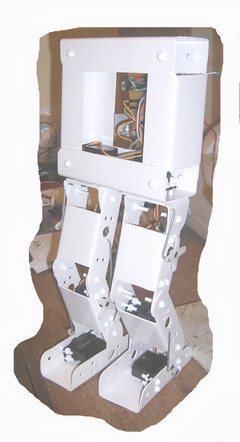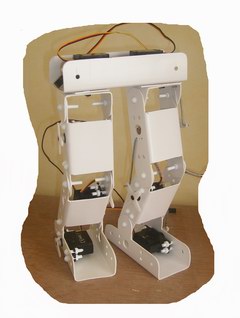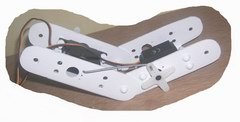 Mechanics
MechanicsThe design was acceptable. The construction was rapid and the result showed the haste. The pushrods were a mistake. They introduced far too much slack into the system, particularly when the joints were at their most straight. Consequently, movement required to be slow in order to avoid overshooting a slop-point.
Having raved about how great the little plastic rivets were, they turned out not to be so good. The interference-fit rings which held the rivets in place seemed to split reasonably often and in many cases I reverted back to M4 bolts with nylock nuts.
Software

The PIC software was allright. It was always jerky: the bot sometimes looked like it was shivering. I suspect this is because so many clock cycles were used in the main loop that the length of the high part of the output pulse was in a state of flux. I can't see a way of demonstrating this without a digital storage scope. The communications protocol was spectacularly robust.
Electronics
With analog electronics not my forte, I often wondered if my power distribution (a handful of 1A regulators powered in parallel, each distributing power to a group of the servos) mechanism was the best approach. I couldn't think of an alternative. It didn't overheat, which may be more of a comment on the large chunk of aluminium I hung off it. That aside, I definitely selected the correct microcontroller for the job and the TTL/RS-232 interface is an amazing little chip. I should have included In-Circuit Serial Programming (ICSP).
Future Work
I need to think a little more about the mechanical side of things to reduce the amount of slop in the joints. I need a more powerful motor or a completely different mechanism to shift the balancing weight around.
In summary, for a first project a biped was probably over ambitious. Maybe I should cut my teeth on a hexapod next!





No comments:
Post a Comment